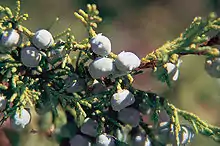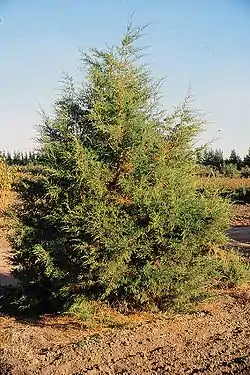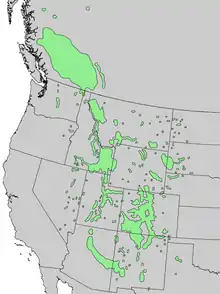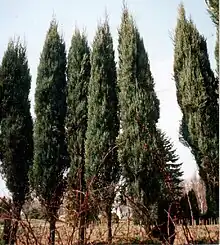Juniperus scopulorum
Juniperus scopulorum, the Rocky Mountain juniper, is a species of juniper native to western North America, from southwest Canada to the Great Plains of the United States.

| Juniperus scopulorum | |
|---|---|
 | |
| Juniperus scopulorum in North Dakota | |
| Scientific classification | |
| Kingdom: | Plantae |
| Clade: | Tracheophytes |
| Clade: | Gymnosperms |
| Division: | Pinophyta |
| Class: | Pinopsida |
| Order: | Cupressales |
| Family: | Cupressaceae |
| Genus: | Juniperus |
| Species: | J. scopulorum |
| Binomial name | |
| Juniperus scopulorum | |
 | |
| Natural range of Juniperus scopulorum | |
Description
Juniperus scopulorum is a small evergreen conifer reaching 5–15 metres (16–49 feet), rarely to 20 m, tall, with a trunk up to 1 m (3 ft 3 in), rarely 2 m, in diameter. The shoots are slender, 0.7–1.2 millimetres (1⁄32–1⁄16 in) diameter. The leaves are arranged in opposite decussate pairs, or occasionally in whorls of three; the adult leaves are scale-like, 1–3 mm long (to 5 mm on lead shoots) and 1–1.5 mm (1⁄32–1⁄16 in) broad. The juvenile leaves (on young seedlings only) are needle-like, 5–10 mm long. The seed cones are berry-like, globose to bilobed, 5–9 mm (3⁄16–11⁄32 in) in diameter, dark blue with a pale blue-white waxy bloom,[2] and contain two seeds (rarely one or three); they are mature in about 18 months[3][4][5] and are eaten by wildlife.[6] The pollen cones are 2–4 mm (3⁄32–5⁄32 in) long, and shed their pollen in early spring. It is dioecious, producing cones of only one sex on each tree.[3][4][5] Rocky Mountain juniper is an aromatic plant. Essential oil extracted from the trunk is prominent in cis-thujopsene, α-pinene, cedrol, allo-aromadendrene epoxide, (E)-caryophyllene, and widdrol. Limb essential oil is primarily α-pinene and leaf essential oil is primarily sabinene. [7]
One particular individual, the Jardine Juniper in Utah, is thought to be over 1,500 years old,[8] while a dead trunk found in New Mexico was found to have 1,888 rings; older trees in the same area are suspected to exceed 2,000 years.[9]
Similar species
Juniperus scopulorum is closely related to J. virginiana, and often hybridizes with it where their ranges meet on the Great Plains. Hybrids with J. horizontalis also occur.
Isolated populations of junipers occur close to sea level in the Puget Sound area in Washington Park near Anacortes and southwestern British Columbia in a park called Smugglers Cove. In both locales, there are a considerable number of young and old specimens. Previously included in J. scopulorum, it has recently been shown to be genetically distinct, and has been described as a new species J. maritima. It is a cryptic species barely distinguishable on morphology, though it does differ in phenology, with the cones maturing in 14–16 months, and often has the tips of the seeds exposed at the cone apex.[10]
Taxonomy
Scopulorum means "of the mountains".[11]
Distribution and habitat
The species is native to western North America, in Canada in south British Columbia and southwest Alberta, in the United States sporadically from Washington east to North Dakota, south to Arizona and also locally western Texas, and northernmost Mexico from Sonora east to Coahuila. It grows at altitudes of 500–2,700 m (1,600–8,900 ft) on dry soils, often together with other juniper species.[3][4][9][5] It requires about 25 centimetres (9+7⁄8 in) of annual precipitation.[2]
Ecology
The Bohemian waxwing eats the berries. According to one study, a single bird consumed 900 in five hours.[2]
Uses
Some Plateau Indian tribes boiled an infusion from the leaves and inner bark to treat coughs and fevers. The cones were also sometimes boiled into a drink used as a laxative and to treat colds.[12] Among many Native American cultures, the smoke of the burning juniper is used to drive away evil spirits prior to conducting a ceremony, such as a healing ceremony.[13]
A small quantity of ripe berries can be eaten as an emergency food or as a sage-like seasoning for meat. The dried berries can be roasted and ground into a coffee substitute.[14] The tree is sometimes planted as a windbreak and horticulturally in rocky, poorly irrigated soils.[2]

The cultivar 'Skyrocket' is a very popular ornamental plant in gardens, grown for its very slender, strictly erect growth habit. Due to its disposition for a fungal disease, namely cedar apple rust, caused by Gymnosporangium juniperi-virginianae,[15] 'Skyrocket' is more and more replaced by the new cultivar J. virginiana 'Blue Arrow'. 'Blue Arrow' is a recipient of the Royal Horticultural Society's Award of Garden Merit.[16] Several other cultivars are also grown to a lesser extent. It is also a popular collected tree for bonsai in the U.S.
References
- Farjon, A. (2013). "Juniperus scopulorum". IUCN Red List of Threatened Species. 2013: e.T42252A2967054. doi:10.2305/IUCN.UK.2013-1.RLTS.T42252A2967054.en. Retrieved 19 November 2021.
- Arno, Stephen F.; Hammerly, Ramona P. (2020) [1977]. Northwest Trees: Identifying & Understanding the Region's Native Trees (field guide ed.). Seattle: Mountaineers Books. pp. 177, 179–180. ISBN 978-1-68051-329-5. OCLC 1141235469.
- Farjon, A. (2005). Monograph of Cupressaceae and Sciadopitys. Royal Botanic Gardens, Kew. ISBN 1-84246-068-4
- Adams, R. P. (2004). Junipers of the World. Trafford. ISBN 1-4120-4250-X
- Flora of North America: Juniperus scopulorum
- Whitney, Stephen (1985). Western Forests (The Audubon Society Nature Guides). New York: Knopf. p. 371. ISBN 0-394-73127-1.
- "Aromatic profiles of trunk, limb, and leaf essential oils of Juniperus scopulorum (Cupressaceae) from Utah" (PDF). Phytologia. 103: 10–17.
- Utahlink: Jardine Juniper
- Gymnosperm Database: Juniperus scopulorum Retrieved January 1, 2008
- Adams, R. P. (2007). "Juniperus maritima, the seaside juniper, a new species from Puget Sounds, North America" (PDF). Phytologia. 89 (3): 263–283. Archived from the original (PDF) on July 21, 2011.
- Great Basin Wildflowers, Laird R. Blackwell, p. 24
- Hunn, Eugene S. (1990). Nch'i-Wana, "The Big River": Mid-Columbia Indians and Their Land. University of Washington Press. p. 354. ISBN 0-295-97119-3.
- Lyon, William S. (1998). Encyclopedia of Native American Healing. W.W. Norton & Company, Inc. p. 173. ISBN 0-393-31735-8.
- Elias, Thomas S.; Dykeman, Peter A. (2009) [1982]. Edible Wild Plants: A North American Field Guide to Over 200 Natural Foods. New York: Sterling. p. 194. ISBN 978-1-4027-6715-9. OCLC 244766414.
- [http%3A%2F%2Fweb.aces.uiuc.edu%2Fvista%2Fpdf_pubs%2F802.pdf&ei=t-0rS_rQDISmnQP035zSCg&usg=AFQjCNFUnGDxh-pryWr9xz2zam0ZDIRqug]
- "Juniperus scopulorum 'Blue Arrow'". RHS. Retrieved 26 September 2020.
